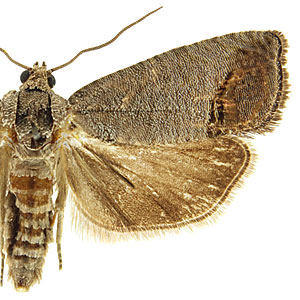Adult Recognition

FWL: 6.5-11.0 mm
Forewings are gray with silvery striations. The ocellus is dark purplish brown and is edged with metallic gold or copper scales. Hindwings are grayish brown and males have a fold along the base of the cubital vein that contains a hair pencil with long black sex scales. Male genitalia are characterized by a ventrally projecting spur at the base of the cucullus. Female genitalia are characterized by a short sclerotized ductus bursae.
Adults may appear similar to dark individuals of Cydia splendana. Cydia pomonella can be separated from C. splendana by the metallic scales surrounding the ocellus and the hair pencil on the male hindwing. A genitalic dissection can be used to confirm identity.
Larval Morphology

For information on the larva of Cydia pomonella, please consult the fact sheet and keys on LepIntercept - An identification resource for intercepted Lepidoptera larvae.
Biology

Cydia pomonella completes 2-4 generations per year. In North America, adults are present in many locations from April through September.
Females lay eggs singly on fruits, stems, or leaves of the host. Larvae tunnel into fruit to feed on the seeds. Larval damage to fruit is characterized by entry and exit holes, rot that surrounds larval feeding areas, and frass accumulation. Mature larvae exit the fruit and create a cocoon under tree bark or in leaf litter; overwintering occurs as a prepupa.
Host plantsCydia pomonella is the most widely distributed and important pest of apple, pear, and walnuts in the world. Other larval hosts include almond, apricot, fig, macadamia, nectarine, peach, plum, prune, and quince. Wearing et al. 2001 provide evidence that sweet cherry (Prunus avium) is not a larval host.
Larvae were intercepted on Citrus in 2009, confirming Rutaceae as a larval host.
| Family | Genus/species | Common name |
| Fagaceae | Castanea sativa Mill. | European chestnut |
| Juglandaceae | Juglans L. | walnut |
| Juglandaceae | Juglans regia L. | English walnut |
| Moraceae | Ficus carica L. | edible fig |
| Proteaceae | Macadamia F. Muell. | macadamia |
| Rosaceae | [unspecified] | |
| Rosaceae | Cydonia oblonga Mill. | quince |
| Rosaceae | Malus domestica Borkh. | apple |
| Rosaceae | Malus Mill. | apple |
| Rosaceae | Malus pumila Mill. | paradise apple |
| Rosaceae | Malus sylvestris (L.) Mill. | European crab apple |
| Rosaceae | Prunus L. | |
| Rosaceae | Prunus persica (L.) Batsch | peach |
| Rosaceae | Pyrus communis L. | common pear |
| Rosaceae | Pyrus L. | pear |
| Rosaceae | Sorbus aria (L.) Crantz | chess-apple |
| Rutaceae | Citrus L. | citrus |
Distribution

Cydia pomonella is found in nearly all temperate pome fruit-growing regions of the world. It is notably absent from Japan and Korea.
References

Barnes, M. M. 1991. Codling moth occurance, host race formation, and damage, pp. 313-327. In L. P. S. van der Geest and H. H. Evenhius [eds.], Tortricid Pests: Their Biology, Natural Enemies, and Control. World Crop Pests, Vol. 5. Elsevier, Amsterdam.
Brown, R. 1979. The valid generic and tribal names for the codling moth, Cydia pomonella (Olethreutinae: Tortricidae). Annals of the Entomological Society of America. 72: 565-567.
Brown, J. W. 2006. Scientific names of pest species in Tortricidae (Lepidoptera) frequently cited erroneously in the entomological literature. American Entomologist. 52: 182-189.
Falcon, L. A. and J. Huber. 1991. Biological control of the codling moth, pp. 355-369. In L. P. S. van der Geest and H. H. Evenhius [eds.], Tortricid Pests: Their Biology, Natural Enemies, and Control. World Crop Pests, Vol. 5. Elsevier, Amsterdam.
Gilligan, T. M., D. J. Wright and L. D. Gibson. 2008. Olethreutine moths of the midwestern United States, an identification guide. Ohio Biological Survey, Columbus, Ohio. 334 pp.
MacKay, M. R. 1959. Larvae of the North American Olethreutidae (Lepidoptera). Canadian Entomologist Supplement 10: 1-338.
Wearing, C. H., J. D. Hansen, C. Whyte, C. E. Miller and J. Brown. 2001. The potential for spread of codling moth (Lepidoptera: Tortricidae) via commercial sweet cherry fruit: a critical review and risk assessment. Crop Protection. 20: 465-488.
[Numerous other important codling moth references are not listed here; consult Wearing et al. 2001 for an expanded list]
Photo Credits

Figs. 6-12: Whitney Cranshaw, Colorado State University, Bugwood.org













